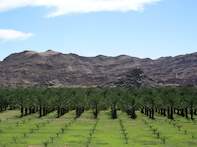
Yield (tonnes per hectare)
8 years old about 1 to 2 tonnes
12 years old about 8 tonnes+
When in full production:
Conservative: 6 tonnes
Average: 8 tonnes
Good: 12+ tonnes
Harvesting
Harvesting is done by hand with ladders or mechanical ladders. The entire bunches are removed and sorted in a suitable sorting and pack house. There are three stages at which harvesting takes place.
The Khalal stage is when the fruit is physiologically mature and is still hard and crisp. The moisture content is above 50% but below 80 %. The colour of the fruit is a bright yellow or red colour. At this stage it is very perishable and is best kept under cold storage. At this stage the dates are marketed as fresh fruit.
The Rutab stage is when the fruits have partially browned and the fruit has a reduced moisture content of around 40 % and the fibres have softened. At this stage the fruit is still perishable. This is the most popular stage of marketing and consumption.
The Tamar stage yields a fruit of an amber to dark brown color and the moisture content is further reduced to below 25%. The texture is now soft pliable to fi rm and slightly hard. At this stage the dates can be kept without any special precautions for longer periods like at room temperature in the food cupboard.
Storage
Storage of the fruit at the three stages of maturity are as follows:
The Khalal stage fruit is stored at +1°C and can be stored for 8 to 10 weeks.
The Rutab stage fruit is stored at 0°C and can be kept for up to 8 months.
The Tamar stage fruit can be stored at 0°C for up to a year. At this stage the date are reasonably hardy and are able to be kept at 18°C or less for a year. When stored at ambient temperature they become dehydrated, lose weight, become hard and the sugar chrysalises in the fruit. Rehydration practices are performed on this fruit to increase and keep the quality.
Pests
Beetles, Locusts, Nematodes, Palm weevil, Red and White scale, Termites and Rodents
Diseases
Bayoud disease, Belaat, Medjnoon, Diplodia, Graphiola, Khamedj.